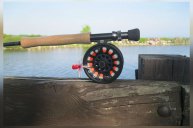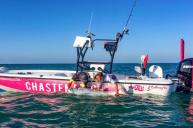Bonefish tested in South Florida contain traces of pharmaceutical contaminants.
Some unexpected data has shown up in a study that can be generally summed up as drug testing for saltwater fish species in Florida.
The troubling findings are a part of a research project that goes back three years that looked for traces of pharmaceutical contaminants found in bonefish in Biscayne Bay and the Florida keys.
Florida International University scientist Dr. Jennifer Rehage and the Bonefish & Tarpon Trust (BTT) research associates, in partnership with Sweden's Umeå University, sampled 93 bonefish in South Florida, finding an average of five pharmaceuticals per bonefish. In fact, traces of a mind-boggling 17 different drugs were found in a single fish captured in Biscayne Bay.
The ever expanding list of drugs includes antidepressants, heart medications, opioids, and antibiotics just to name a few. Sadly, pharmaceutical waste originates most often from human wastewater which are not removed by conventional water treatment systems.
Now, they are being found in these sportfish, which could ultimately have negative consequences on reproduction rates and survival. As the news release announcing the findings stated, "Pharmaceutical contaminants have been shown to affect all aspects of the life of fish, including their feeding, activity, sociability, and migratory behavior."
In a FIU news article, Dr. Rehage was quoted as saying, "These findings are truly alarming. Pharmaceuticals are an invisible threat, unlike algal blooms or turbid waters. Yet these results tell us that they are a formidable threat to our fisheries, and highlight the pressing need to address our longstanding wastewater infrastructure issues."
What follows is a short video highlighting the study's findings.
We connected with Dr. Rehage to ask a few more questions. Bonefish, along with other gamefish such as permit and tarpon, bring tourism and outdoor recreation revenue to south Florida. The things that affect bonefish as well as the things they eat, places they spawn, and areas they spend most of there time are paramount to guide services and their clients. But on an even bigger scale, these findings could be a harbinger of less than ideal outcomes for the local community.
Our conversation has been edited slightly for clarity.
WOS: Bonefish eat worms, mollusks, shrimp, small crabs, and even eat other fish. Are any of those food species being investigated?
Dr. Rehage: Yes, two to three diet studies show this, and they also eat lots of snails in the Caribbean. Our presentation on the study shows that we also sampled prey (crabs, shrimp, toadfish) and they have more pharmaceuticals than bonefish, by an average ratio of 11 to 7.
WOS: Is the fact that bonefish feed in such close proximity to the bottom a telling factor in the study?
Dr. Rehage: Exposure can occur through the water, sediment, and/or food. We certainly thought bonefish would be a good model for this study because of their benthic feeding since sediments can harbor contaminants. We have not tested the sediment yet, but will in the future.
WOS: Do you feel that other sportfish species could be affected?
Dr. Rehage: Yes, if it's in the shrimp, crabs, and small fish, then other coastal fish should be affected since they all rely on the same prey.
WOS: Are there any plans to study tarpon and permit?
Dr. Rehage: No, not at this time.
The work Dr. Rehage and her team are doing could weigh in on the economic impact of sportfishing in Florida as we learn more about what this threat may mean to those who are a part of this community.
More on the Bonefish & Tarpon Trust
As outdoorsmen and women, the word "conservationist" is used quite often when it comes to our sporting adventures, and rightly so. It is organizations like BTT that continually watch over these waterways with an eye on conservation, so as to save it and share it with future generations.
BTT is supporting and executing the on-the-ground work to help us better understand the species and habitat that are so interconnected.
They've been around since 1997, and continue working to implement things like catch and release regulations for bonefish and tarpon, as well as permit tagging programs.
Making Sense of it All
By now, it should be perfectly clear to all of us that water quality isn't just another mantra for those of us that care about fishing. Real change needs to be made that can and will keep our waters safe.
But this issue has only just been discovered without a chance to address it yet. Pharmaceutical pollution bypasses wastewater treatment plants since there is currently no conventional filtering or cleaning system that can remove it.
While Florida has passed major legislation to modernize its water policies and provided historic funding for water quality issues, this is yet another contaminant that affects waterways and it needs to be dealt with.
We have BTT, FIU, Dr. Rehage and her team, and the support from Umeå University to thank for unearthing this information, but what we do about it will take more time and effort. With habitat loss and freshwater flow alterations already having an impact on the South Florida flats fishery, this adds another to the list of concerns.
Please check out my book "The Hunter's Way" from HarperCollins. Be sure to follow my webpage, or on Facebook and YouTube. Go to Rack Hub and use the coupon code Craiger for a new way to display those antler sheds!
NEXT: CAPTAINS FOR CLEAN WATER: NONPROFIT GROUP EMPOWERS ADVOCACY FOR BETTER WATER MANAGEMENT




